Chess Notes
Edward Winter
When contacting us by e-mail, correspondents are asked to include their name and full postal address and, when providing information, to quote exact book and magazine sources. The word ‘chess’ needs to appear in the subject-line or in the message itself.
| First column | << previous | Archives [170] | next >> | Current column |
10989. Possible Fischer events
An article by Frank Draper on page 11 of the Evening Standard, 8 March 1973:

10990. Juniors
From our file of Evening Standard cuttings we present a montage of some articles by Leonard Barden:
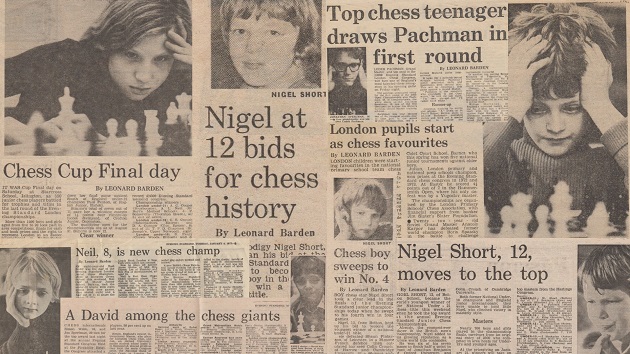
The players are Neil Carr (4 January 1977), Julian Hodgson (11 May 1974), Simone Leberman (7 January 1974), David Norwood (1 August 1977), Nigel Short (28 December 1977, 30 December 1977 and 3 January 1978) and Jonathan Speelman (12 December 1972).
10991. Capablanca in 1909
A better version of the illustration in C.N. 3742 from page 12 of the Topeka Daily State Journal, 7 December 1909:
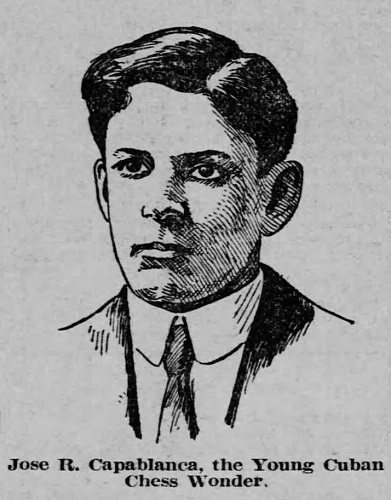
10992. Resignation
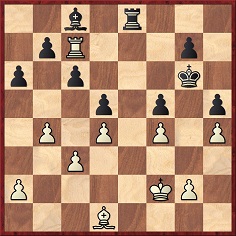
After 31 Be2, was Black justified in resigning?
10993. ‘Book of the Year’
The English Chess Federation’s webpage ‘Book of the Year 2018 shortlist’ miscopies one title, transforming Karjakin into ‘Kajarkin’. (A panel member’s personal webpage goes further, with ‘Kajarkan’.) Nothing is disclosed about the contest’s conditions, such as eligibility in terms of date of publication, or about the three judges’ imagined credentials. The inclusion of S. Tkachenko’s book on Alekhine indicates that proper historical standards are not a requirement.
10994. Chess and war
A sketch on page 297 of the Illustrated London News, 9 March 1940:
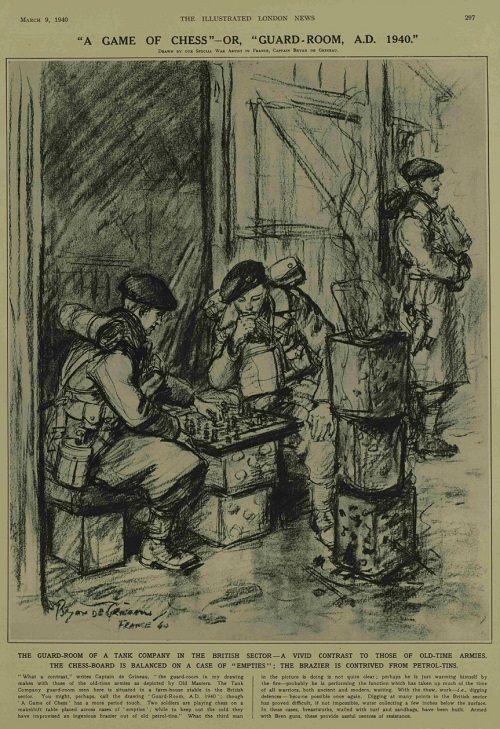
The picture was reproduced on page 161 of CHESS, April 1940.
10995. Hans Müller
Which are the best sources for information about Hans Müller, including his non-chess activities? A paragraph from page 992 of L’Echiquier, March-April 1935:
‘Ce qui est curieux dans le cas de Hans Müller (né en 1896), c’est qu’il est en même temps maître d’escrime, de skis et de lawn-tennis et qu’il a, en outre, publié des travaux intéressants sur la graphologie, la microscopie et sur la philosophie hindoue.’
Below is an autobiographical note on pages 121-122 of Deutsche Schachblätter, 15 April 1938:
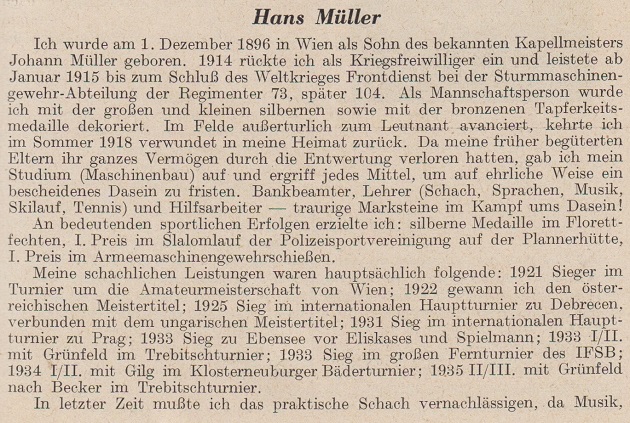

A portrait of Müller on page 122:
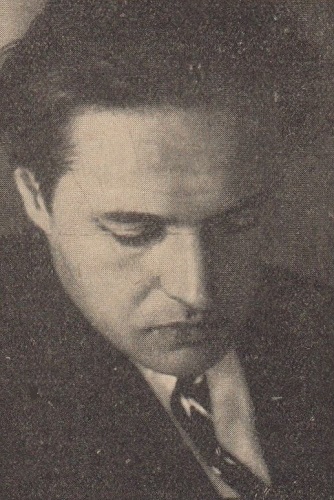
10996. The Wallace murder case
There is a reference to the Wallace murder case in Evil Under the Sun by Agatha Christie (first published in 1941). The passage, at the start of chapter five part five, is shown below from page 71 of a Christie anthology published by Hamlyn, London in 1970. The two police officers and Hercule Poirot have just questioned Kenneth Marshall, the murder victim’s husband:
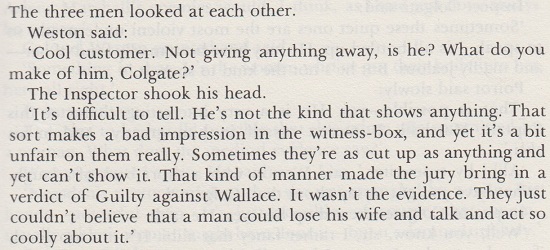
An on-line search reveals a mention of Wallace in Agatha Christie’s posthumous novel featuring Miss Marple, Sleeping Murder:
‘And Wallace, a quiet man whom the jury insisted did kill his wife, though the sentence was quashed on appeal.’
10997. Resignation (C.N. 10992)

After 31 Be2 Black resigned on the grounds that a decisive march by the white king to b8 is unpreventable.
The game, played by correspondence in Berlin between the Café Kaiserhof and the Café Royal, was published on pages 50-51 of the February 1899 Deutsche Schachzeitung:

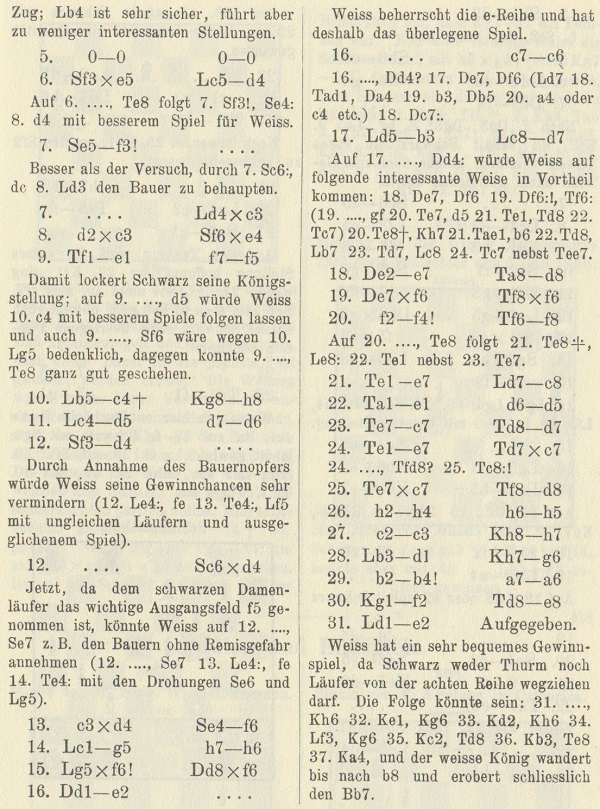
1 e4 e5 2 Nf3 Nc6 3 Nc3 Nf6 4 Bb5 Bc5 5 O-O O-O 6 Nxe5 Bd4 7 Nf3 Bxc3 8 dxc3 Nxe4 9 Re1 f5 10 Bc4+ Kh8 11 Bd5 d6 12 Nd4 Nxd4 13 cxd4 Nf6 14 Bg5 h6 15 Bxf6 Qxf6 16 Qe2 c6 17 Bb3 Bd7 18 Qe7 Rad8 19 Qxf6 Rxf6 20 f4 Rff8 21 Re7 Bc8 22 Rae1 d5 23 Rc7 Rd7 24 Re7 Rxc7 25 Rxc7 Rd8 26 h4 h5 27 c3 Kh7 28 Bd1 Kg6 29 b4 a6 30 Kf2 Re8 31 Be2 Resigns.
From page 13 of Schachjahrbuch für 1899. II. Theil by Ludwig Bachmann (Ansbach, 1900):
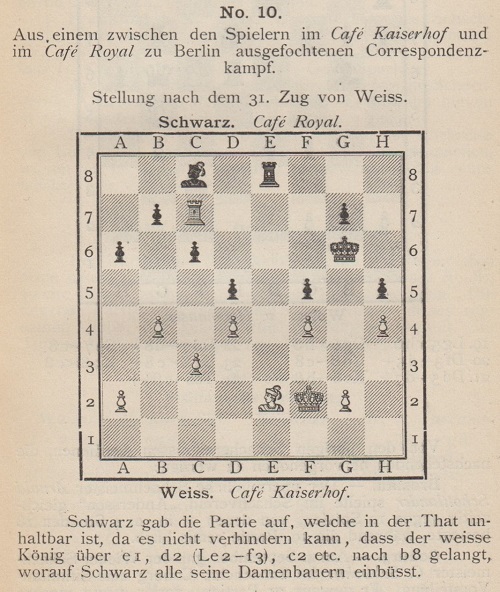
Richard Forster (Zurich) writes:
‘The best line may be 31...Rh8 32 Bf3 Kf6, and now if 33 Ke2 then 33....g6 34 Kd2 Rg8 35 Kc2 Ke6 36 Kb3 Kd6 37 Rh7 b6. The computers suggest 33 a4 g6 34 b5, which wins a pawn and probably gives very good winning chances, but the game is not yet over.’
10998. Alekhine in San Francisco
From page 16 of the San Francisco Chronicle, 28 February 1924:
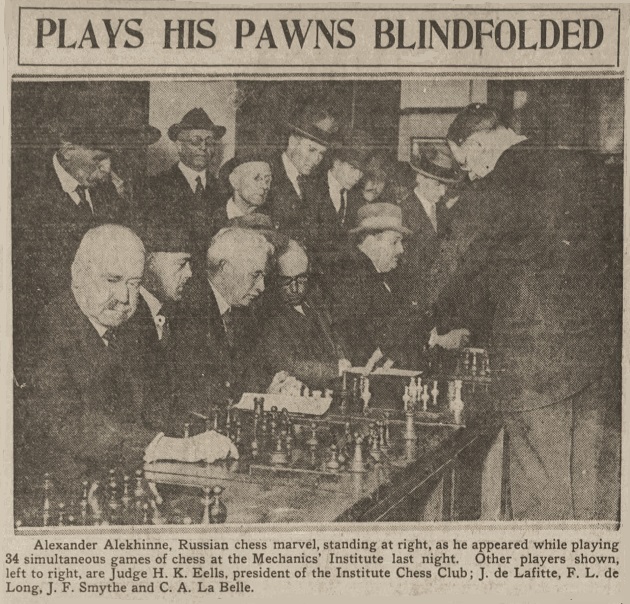
The reference to ‘blindfolded’ in the heading is not to be taken literally. Regarding the number of games played, a chart of Alekhine’s exhibitions in Canada and the United States from November 1923 to April 1924 on page 154 of the July-August 1924 American Chess Bulletin specified 32 (+24 –3 =5), figures also given on pages 217 and 771 of the Skinner/Verhoeven volume on Alekhine. The full chart was reproduced on page 3 of Alekhine in the Americas by J. Donaldson, N. Minev and Y. Seirawan (Seattle, 1992).
A curiosity about Alekhine and Neo-Chess from page 7 of the San Francisco Examiner, 29 February 1924:

10999. The grandmaster title
An observation by W.A. Fairhurst on page 134 of the April 1955 BCM:
‘Many players will agree that there are too many international masters and far too many so-called grandmasters. Lasker, Capablanca and Alekhine could be considered of such high rank amongst the masters of the past that they were entitled to such a distinction as grandmaster, but it is doubtful if there is a single player living at present worthy of this title. Botvinnik, Keres, Smyslov and Reshevsky are all fine players but they have not that superiority over some of the other leading masters which entitles them to be described as “grand”. In addition to these four there are apparently 37 other grandmasters, and this makes the distinction almost meaningless.’
11000. A simultaneous display by Josef Krejcik
From page 191 of The Even More Complete Chess Addict by Mike Fox and Richard James (London, 1993):

The phrase ‘according to Chess’ takes the reader nowhere.
The following is on page 12 of Josef Krejcik’s book Mein Abschied vom Schach (Berlin, 1955):
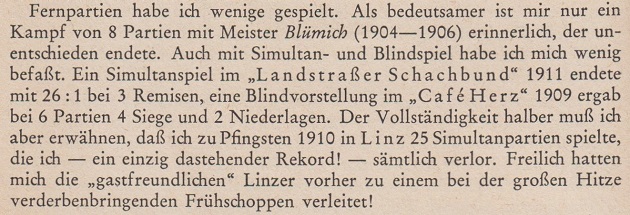
Krejcik states that his hosts had induced him to drink alcohol before the exhibition but places the performance at Whitsun (zu Pfingsten). That undermines the ‘worst birthday present in chess history’ claim, given that he was born on 22 January 1885.
Can information on the display be found in any 1910 publications?
Regarding poor results in simultaneous exhibitions, see too C.N. 2816 (on page 71 of Chess Facts and Fables) and C.N. 6451.
11001. Castling the adversary’s queen
The subsequent item on page 191 of the Fox/James book mentioned in C.N. 11000:

Below is the relevant part of page 103 of Chess Pieces by Norman Knight (London, 1949):
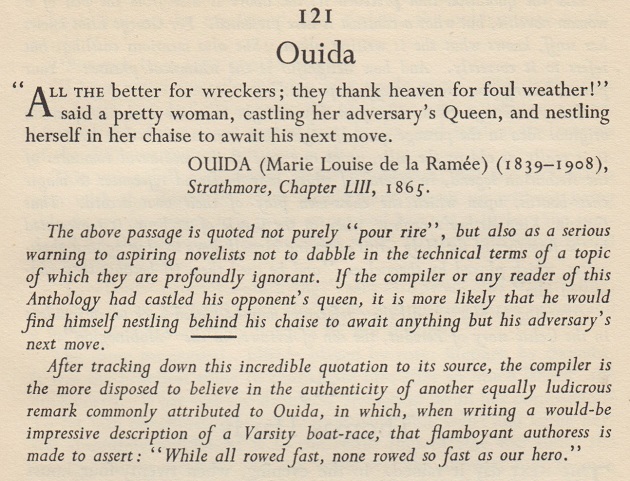
The passage in Strathmore had been disinterred by
Philip H. Williams on
page 281 of the June 1908 Chess Amateur (also with
a comment about nestling behind):
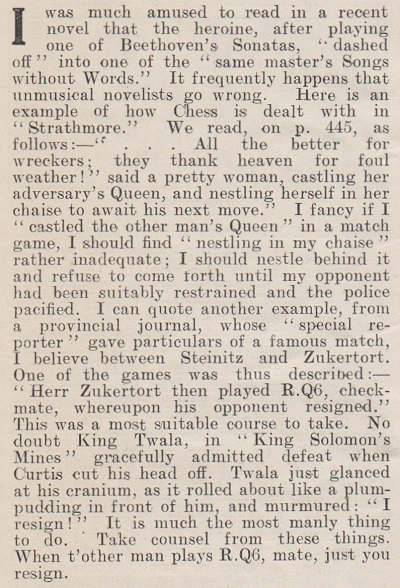
11002. Scheveningen, 1923
From page 189 of CHESS, May 1940, in an article entitled ‘Last-Round Surprises’ by S. Tartakower (pages 186-190):
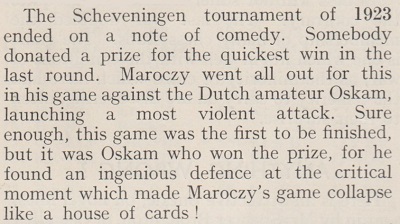
Maróczy annotated his loss to Oskam on pages 101-102 of the Scheveningen, 1923 tournament book published by Bernhard Kagan:
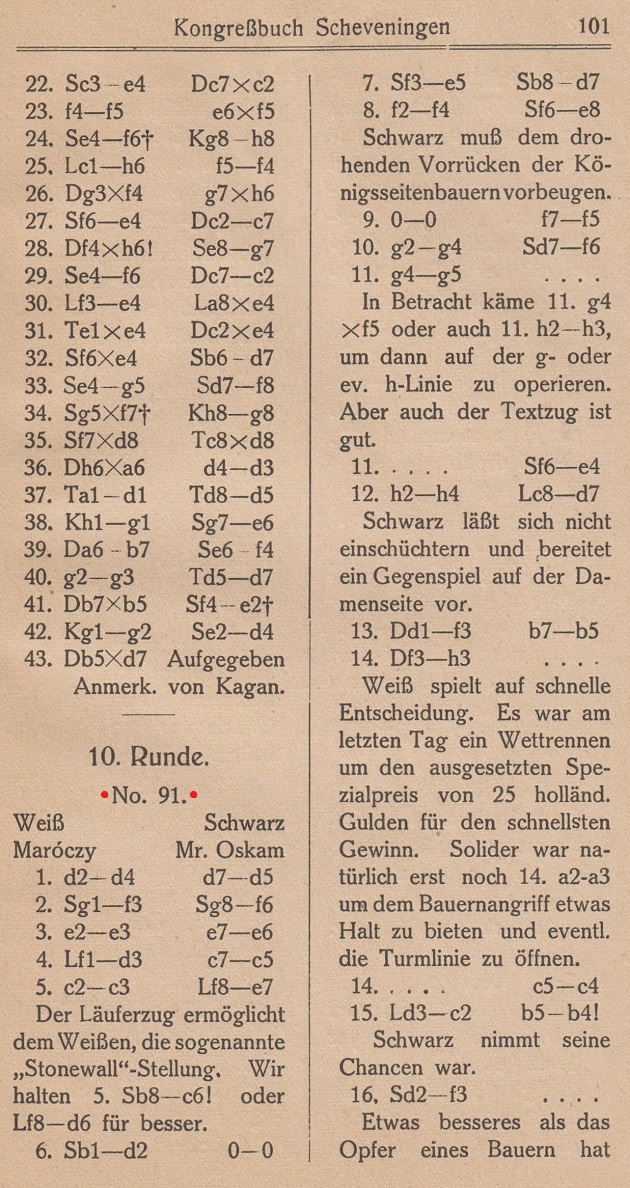
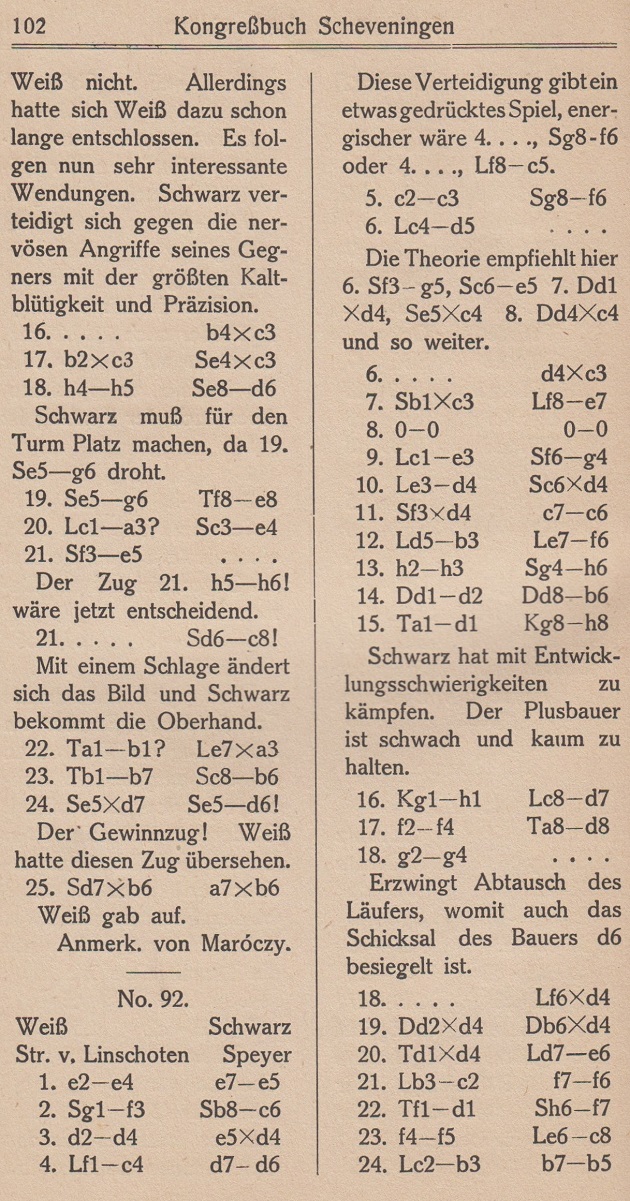
1 d4 d5 2 Nf3 Nf6 3 e3 e6 4 Bd3 c5 5 c3 Be7 6 Nbd2 O-O 7 Ne5 Nbd7 8 f4 Ne8 9 O-O f5 10 g4 Ndf6 11 g5 Ne4 12 h4 Bd7 13 Qf3 b5 14 Qh3 c4 15 Bc2 b4 16 Ndf3 bxc3 17 bxc3 Nxc3 18 h5 Nd6 19 Ng6 Re8 20 Ba3 Nce4 21 Nfe5
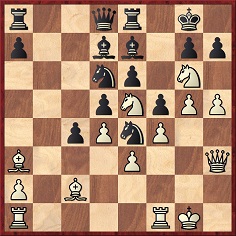
21...Nc8 22 Rab1 Bxa3 23 Rb7 Nb6 24 Nxd7 Nd6 25 Nxb6 axb6 26 White resigns.
However, according to pages 104-105 of the tournament book it was another game, Johner v Fick, which won the prize for the first game to end in the final round:
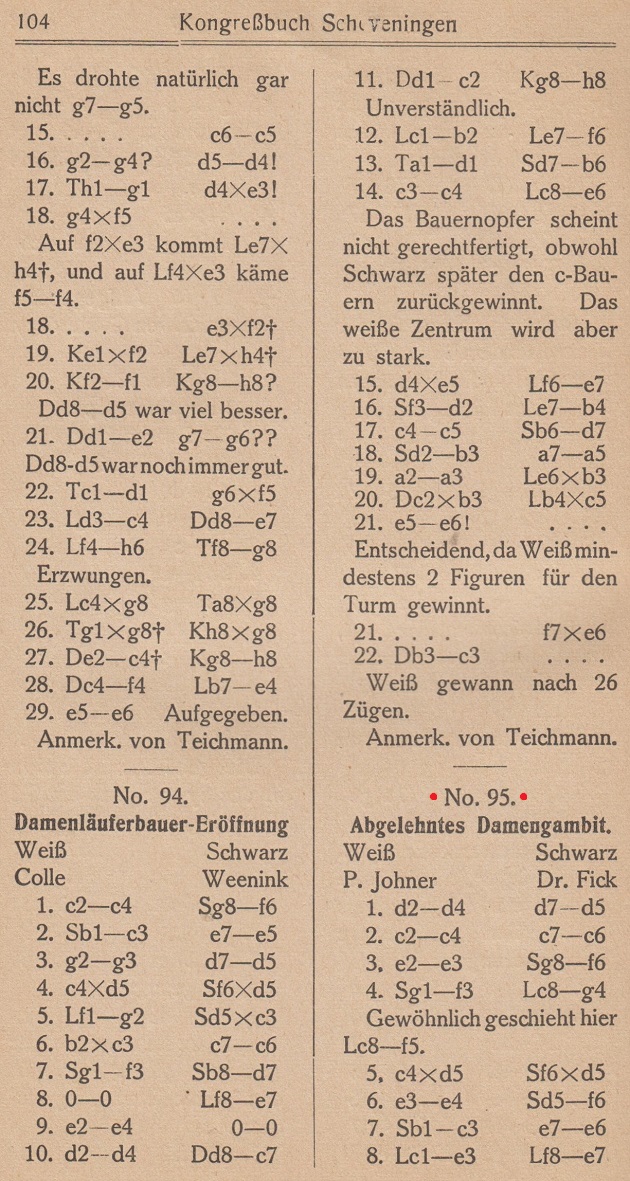
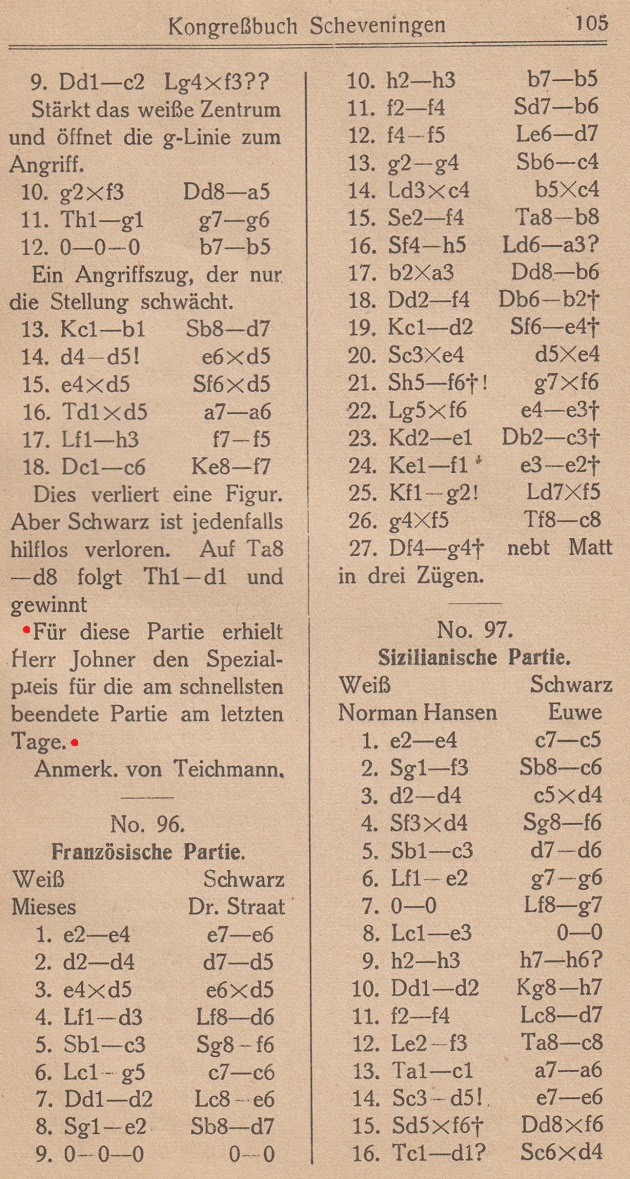
1 d4 d5 2 c4 c6 3 e3 Nf6 4 Nf3 Bg4 5 cxd5 Nxd5 6 e4 Nf6 7 Nc3 e6 8 Be3 Be7 9 Qc2 Bxf3 10 gxf3 Qa5 11 Rg1 g6 12 O-O-O b5 13 Kb1 Nbd7

14 d5 exd5 15 exd5 exd5 16 Nxd5 Nxd5 17 Rxd5 a6 18 Bh3 f5 19 Qc6 [Kf7 and Black resigns].
In the exchanges on d5 a pair of moves was missing from the tournament book, and our game-score above follows what appeared on page 3 of the Nieuwe Rotterdamsche Courant, 4 August 1923, which discussed both games:
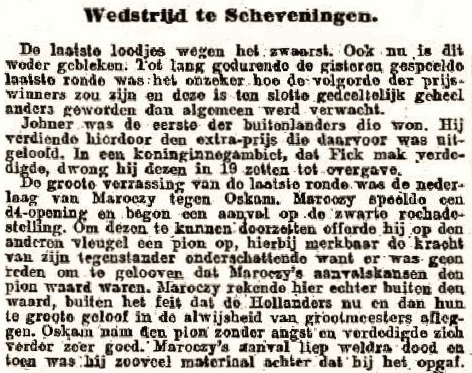
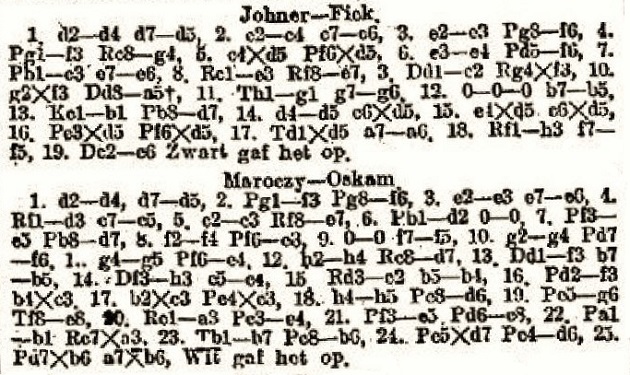
11003. FIDE politics: a basic question (C.N. 10923)
C.N. 10923 suggested a basic question to ask anybody aspiring to lead FIDE:
If you are elected FIDE President, what are the main specific changes that the chess world will see A) after one year, and B) after four years?
The question has been put to Arkady Dvorkovich by Macauley Peterson in a ChessBase interview.
11004. Pitiful
Mention of Arkady Dvorkovich in C.N. 11003 prompts Olimpiu G. Urcan (Singapore) to point out these Twitter exchanges involving Nigel Short and Raymond Keene:
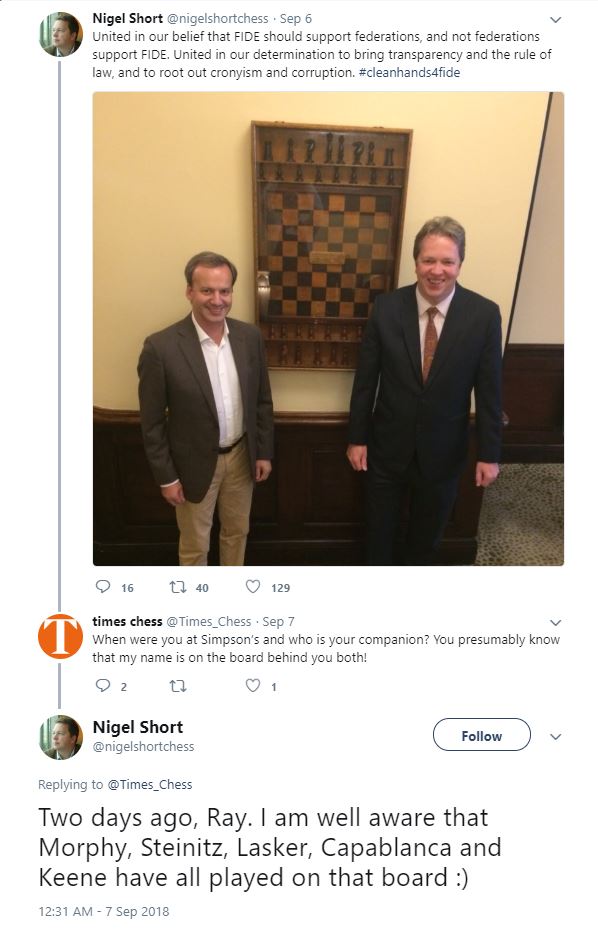
Raymond Keene’s inability to recognize Arkady Dvorkovich is as pitiful as his pride in the defilement of the Simpson’s-in-the-Strand chessboard (as shown on a Kingpin webpage).
11005. The choice of openings
‘The lower the level of play, the less it matters what opening is chosen ...’
C.H.O’D. Alexander, BCM, July 1955, page 216.
11006. A simultaneous display by Josef Krejcik (C.N. 11000)
Peter Anderberg (Harmstorf, Germany) notes pages 36-37 of Krejcik’s book Artige und unartige Kinder der Schachmuse (Leipzig, 1925), which refers to an 11-board simultaneous display (Whitsun, 1910) on peg chess sets (11 losses):
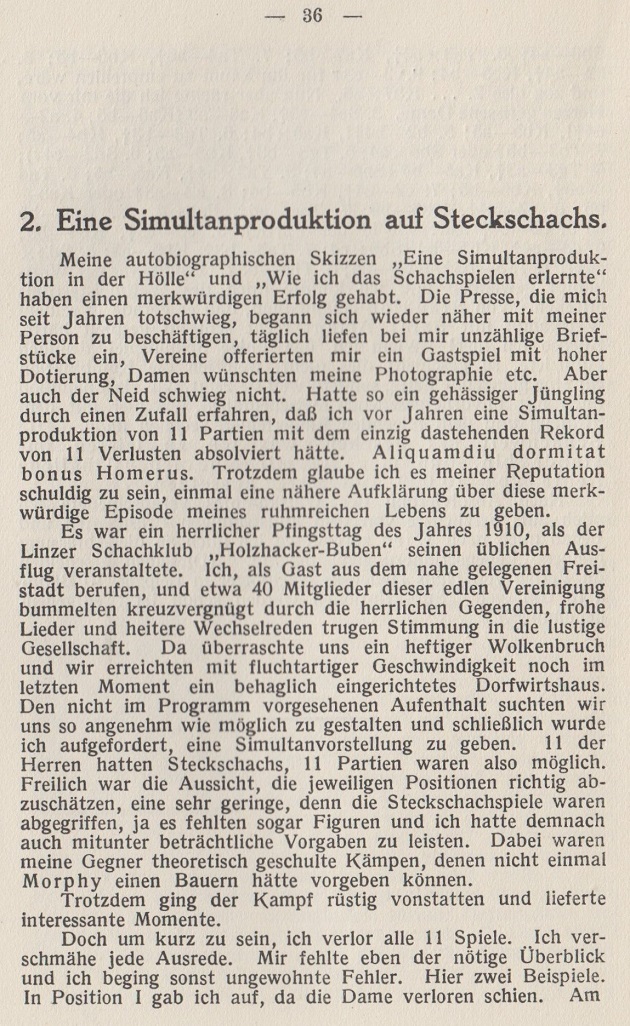
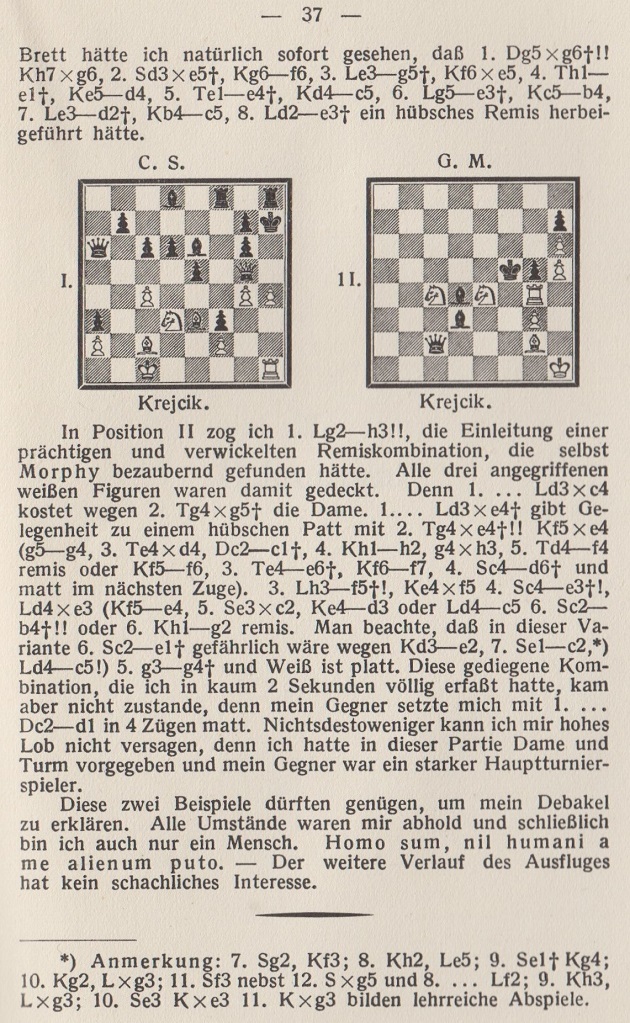
Our correspondent remarks:
‘This text is part of the section “Aus meinem Leben: Dichtung” (“From my Life: Poetry” ), so the entire story seems to be fictitious.’
11007. White to move

This position will be discussed in the next C.N. item.
11008. Victor Rush
From pages 282-283 of the August 1915 BCM:
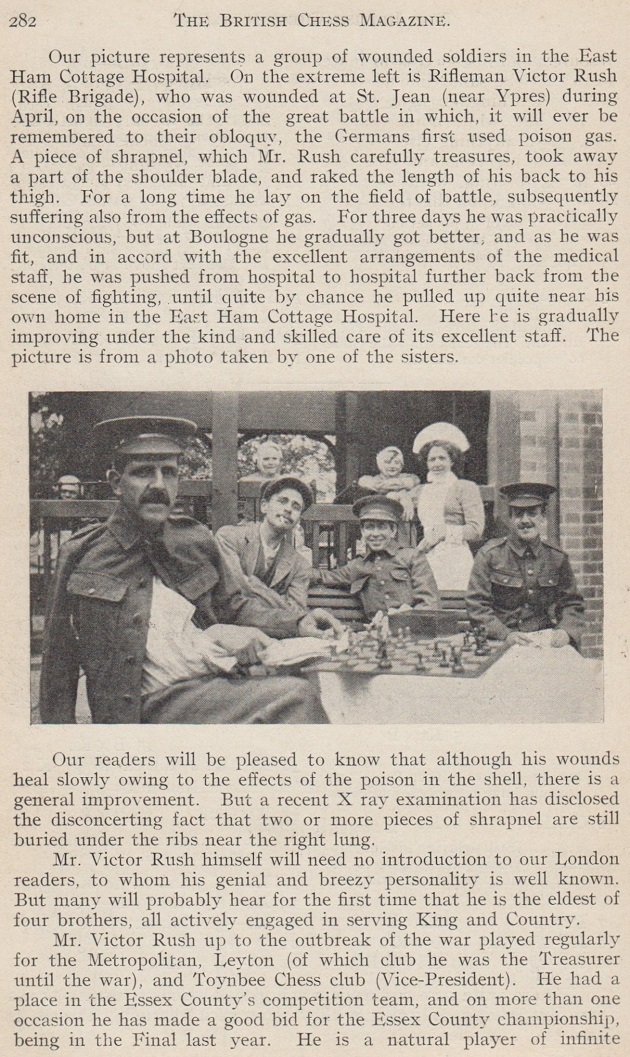
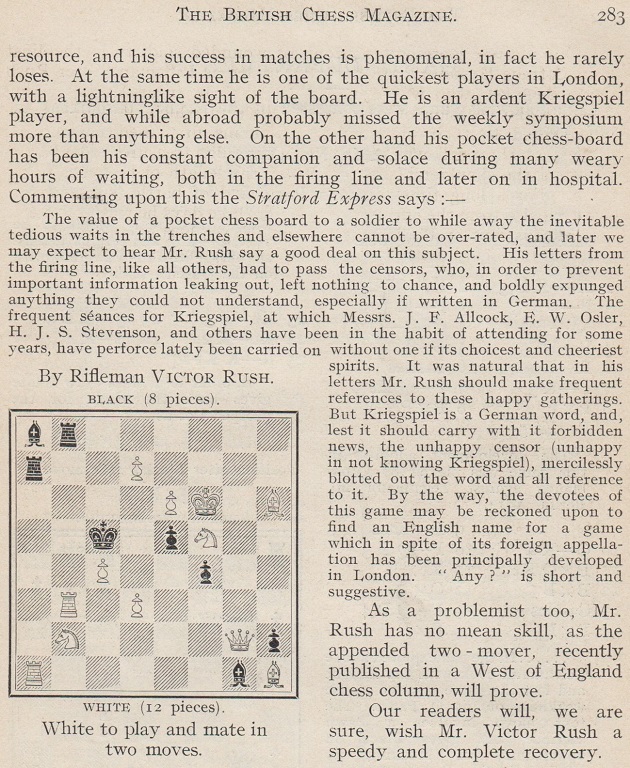
Rush lived until 1951, and a brief obituary is on page 118 of the April 1951 BCM.
This cutting is from Brian Harley’s column in the Observer, 7 April 1935, page 31:
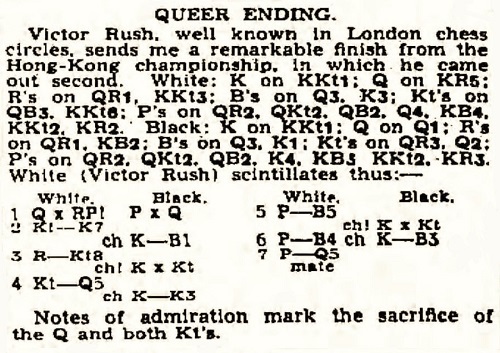
The initial position was shown in C.N. 11007:

Mate in seven: 1 Qxh6 gxh6 2 Ne7+ Kf8 3 Rg8+ Kxe7 4 Nd5+ Ke6 5 f5+ Kxd5 6 c4+ Kc6 7 d5 mate.
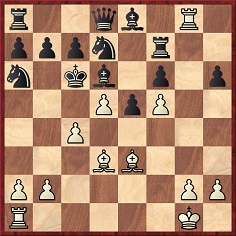
11009. Los Angeles, 1940
From the Los Angeles Times, 8 September 1940, Part L, page 12:
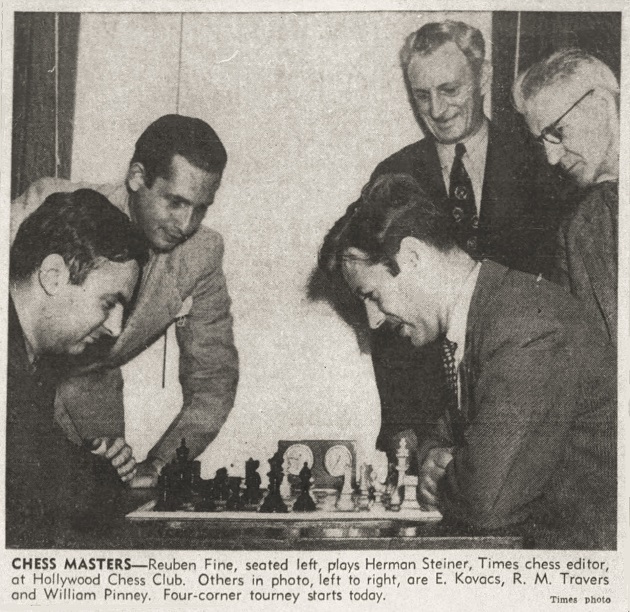
The participants in the tournament were Borochow, Fine, Steiner and Woliston. Page 244 of Reuben Fine by Aidan Woodger (Jefferson, 2004) observed:
‘Fine had a relatively easy time in this tournament (which is erroneously dated 1941 in his autobiography, and hence several other sources).’
11010. Grossmeister
An unusual instance of the term ‘Grandmaster’ to describe a problemist occurs at the start of the obituary of Karl Kockelkorn on page 248 of Schachjahrbuch 1914 II. Teil by Ludwig Bachmann (Ansbach, 1914):
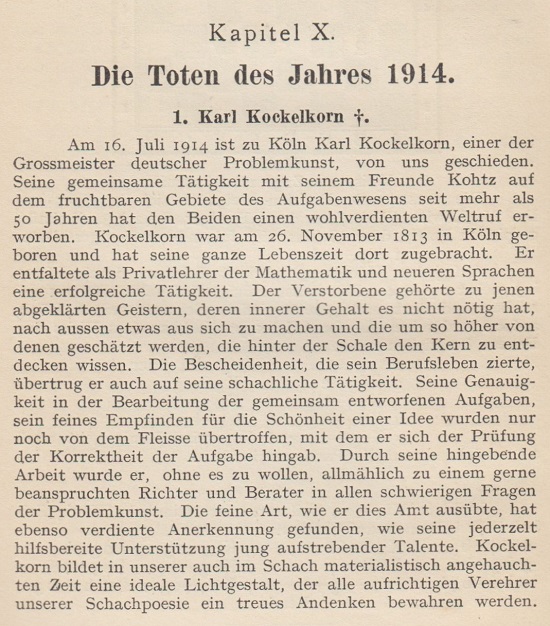
11011. The Wallace murder case
A passage from Chess and the Wallace Murder Case, where we referred to books by Robert F. Hussey and Jonathan Goodman:
On page 171 Hussey wrote: ‘Barrister Abrahams states: “The judge ... summed up strongly for acquittal.”’ He did indeed, and it is perhaps surprising to find the following on page 309 of Goodman:
‘A few years before his death, in an interview with a Liverpool Echo reporter, he [Mr Justice Wright, who took the title Lord Wright of Durley] said:
“Never forget that Wallace was a chessplayer. ... I should say that, broadly speaking, any man with common sense would have said that Wallace’s alibi was too good to be true, but that is not an argument you can hang a man on.”’
Lord Wright died in 1964, but no precise source for the Liverpool newspaper interview was supplied by Goodman.
Now, Gerard Killoran (Ilkley, England) provides the article, which was by Robert Jackson and was published on page 8 of the Liverpool Echo and Evening Express, 27 November 1958:

11012. Josef Krejcik (C.N.s 11000
& 11006)
Harry Golombek’s review of Mein Abschied vom Schach on pages 323-324 of the November 1955 BCM:


Since Golombek singled out the ‘portraitures’, the full set is shown here, on pages 18-22 of Krejcik’s book:
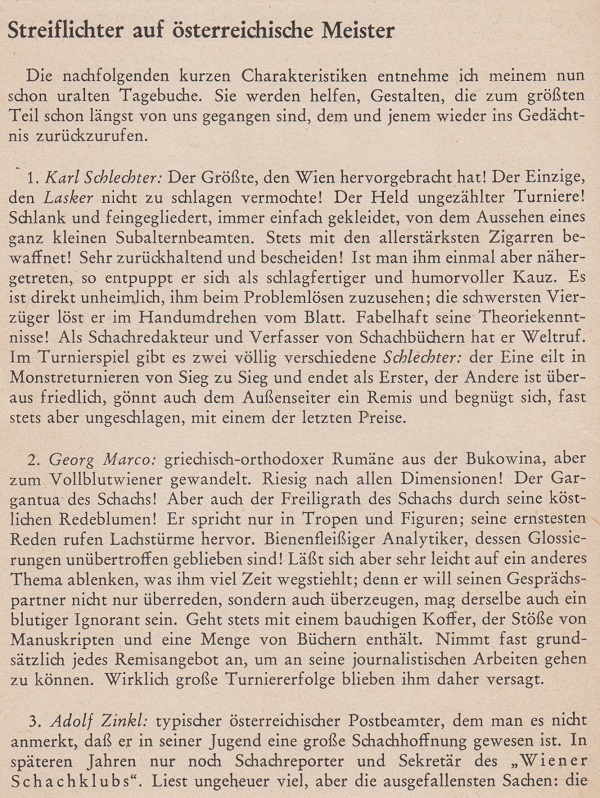
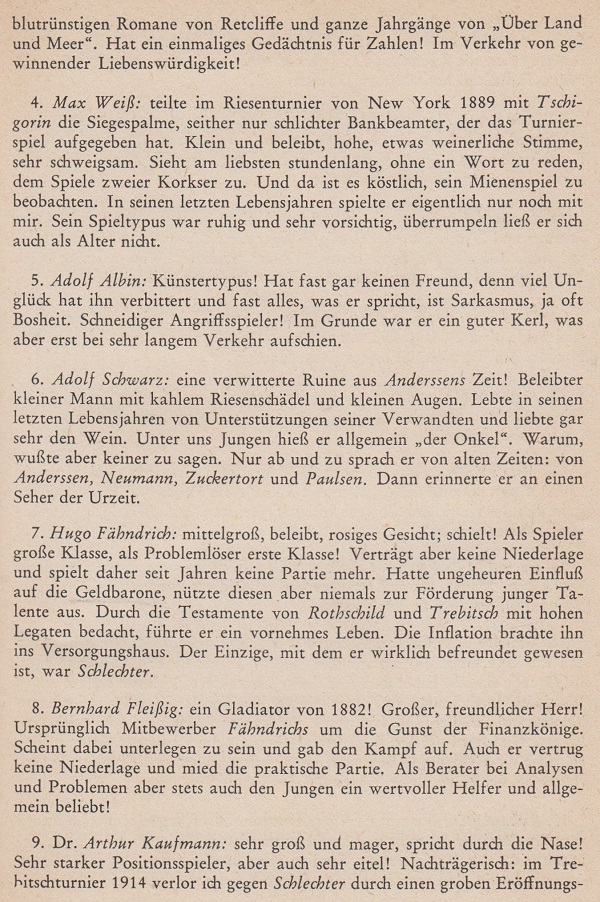
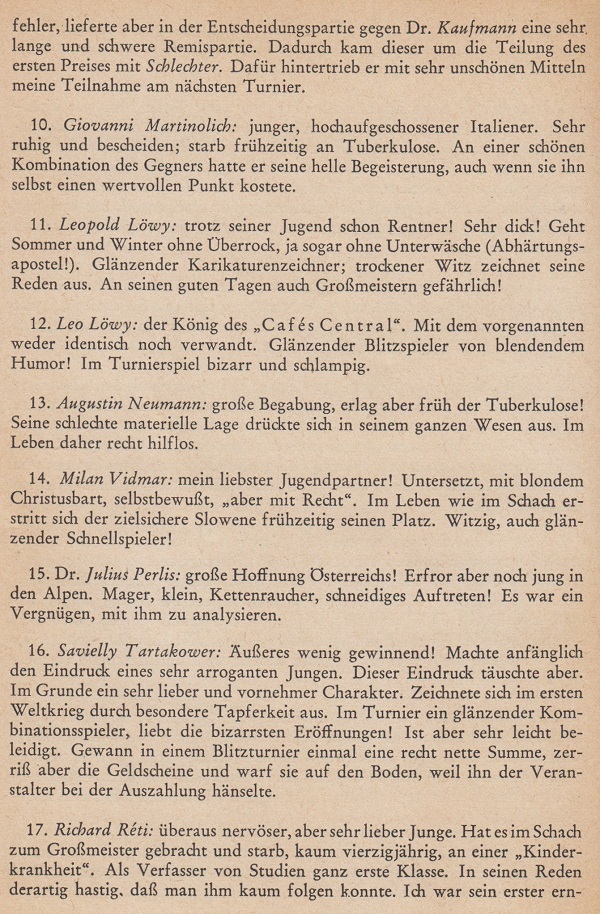
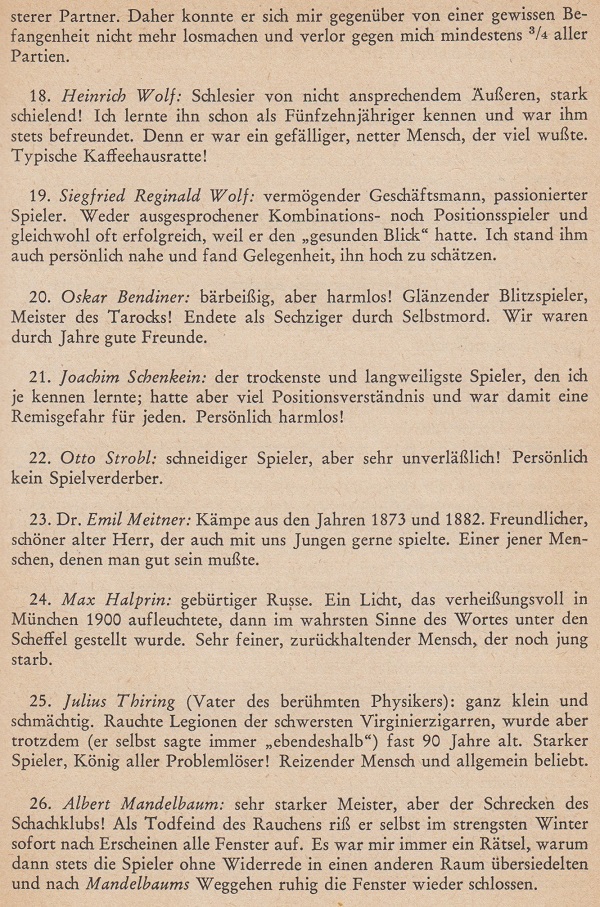

11013. Morgan on Chernev
Immediately after the review of the Krejcik book (C.N. 11012), page 324 of the November 1955 BCM had an assessment by D.J. Morgan of Chernev’s 1000 Best Short Games of Chess:
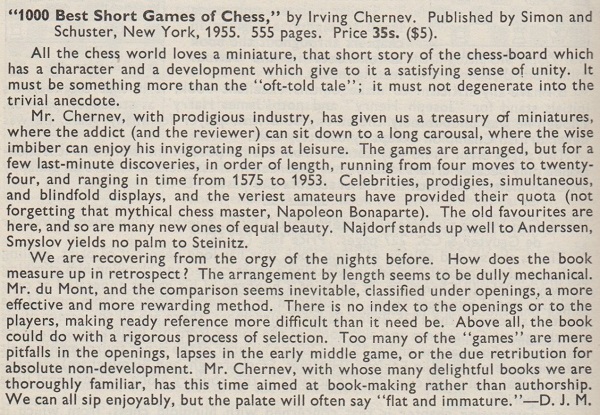
11014. London, 1927
From page 188 of CHESS, May 1940, below is a further extract from the article by Tartakower referred to in C.N. 11002:
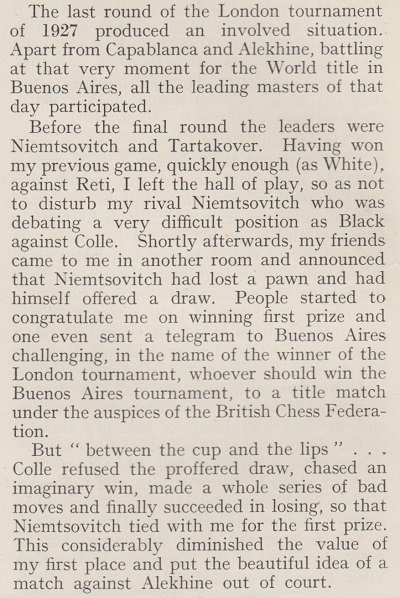
In the first paragraph, the word ‘previous’ is inapposite; Tartakower v Réti was the last-round game. Against Colle, Nimzowitsch was White, not Black; he annotated the game on pages 73-76 of Die Praxis meines Systems (Berlin, 1930).
Having annotated his win over Réti, Tartakower discussed the aftermath of the London, 1927 tournament on page 201 of his first volume of Best Games (London, 1953).
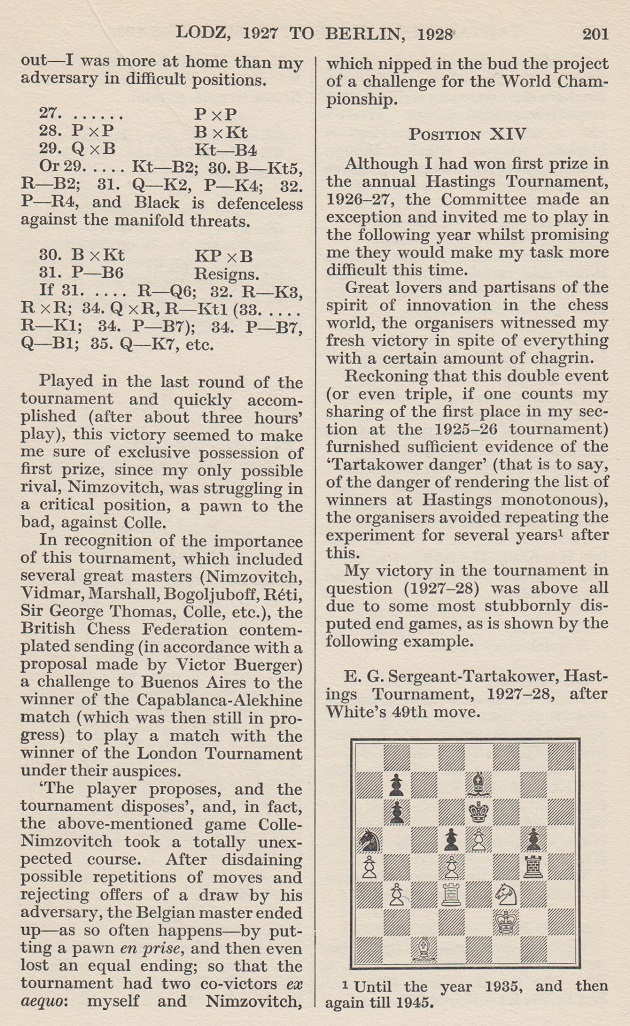
In CHESS, Tartakower stated that a telegram was sent to Buenos Aires, whereas his book had the phrase ‘contemplated sending ... a challenge to Buenos Aires’. On page 270 of the French edition, Tartacover vous parle (Paris, 1953), the wording was ‘envisageait ... de lancer à Buenos-Aires un défi’.
11015. 1 d4 Nf6
A remark by Tartakower on page 37 of the Wiener Schachzeitung, April 1923:

11016. Morphy v Anderssen (C.N. 9519)
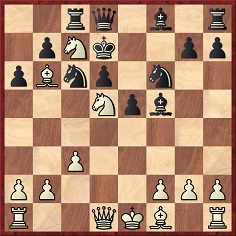
White to move
Regarding this position (a variation given by Tartakower and du Mont), C.N. 9519 showed Edgard Tchélébi’s observation on page 232 of Le secret de Morphy (Limoges, 1960) that White can play 14 Ne6 Qe8 15 Nc5+ dxc5 16 Nxf6+.
We add now that Tchélébi had given similar analysis on page 80 of the February 1955 BCM:
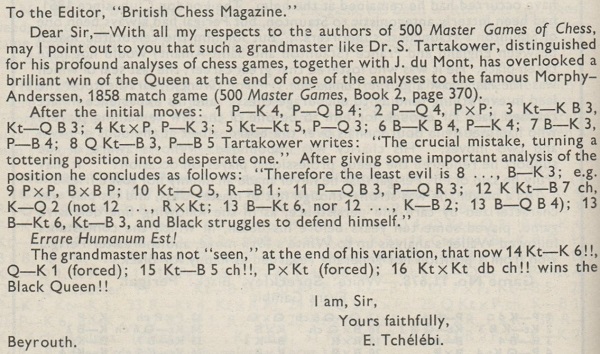
11017. Alekhine’s château (C.N.s 4250, 4251, 4262 & 4345)
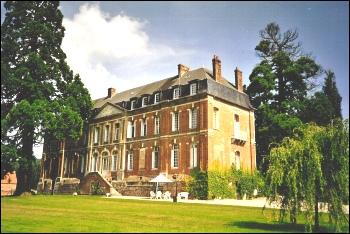
Bob Kane (London) notes another website at which accommodation in Alekhine’s château in St Aubin-le-Cauf can be booked. One photograph at the website is of a room with a chess set.
11018. Records
‘On 17 July 2013, Garry Turner (UK) attached 161 clothes pegs to his face on the set of Rekorlar Dünyasi in Istanbul, Turkey.’
A photograph of Mr Turner’s head, virtually hidden by the attachments, takes up much of page 93 of Guinness World Records 2019 (London, 2018). The book has scores, if not hundreds, of similar items, and especially in the gross ‘Food Feats’ section.
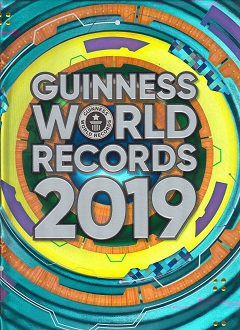
In our annual doleful duty, we note that the 2019 edition has an index entry for clothes pegs but not for chess. However, the latter is mentioned twice in the ‘Stop Press’ section on pages 254-255:
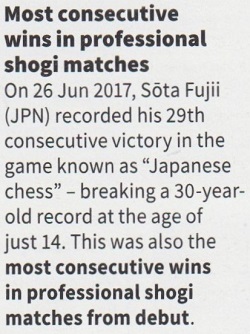
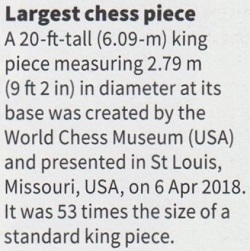
Following on from the latter item, we seek detailed information about the rook in the playing area of the 1974 Olympiad in Nice.
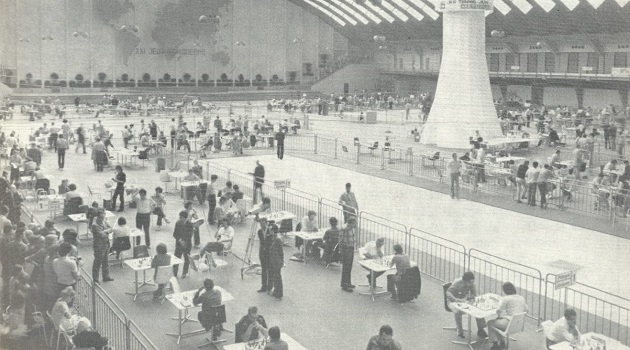
Europe Echecs, 5
July 1974, front cover
The photograph was also on page 155.
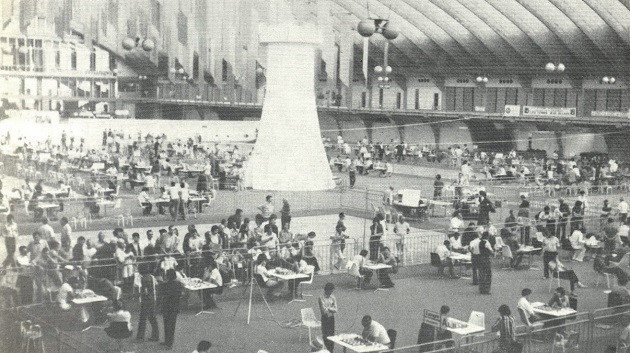
Europe Echecs, 5
August 1974, front cover
(Acknowledgement for the two Europe Echecs
photographs: Cleveland Public Library)
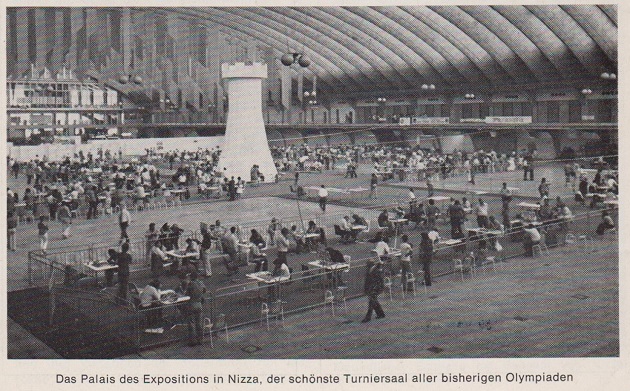
Schweizerische
Schachzeitung, July 1974, front cover
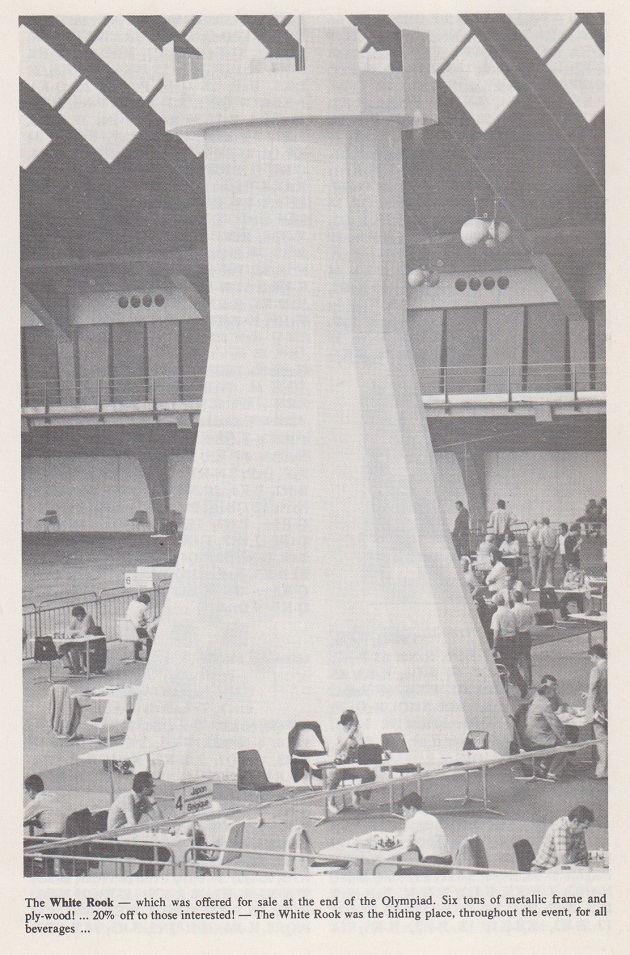
BCM, August 1974, page 291
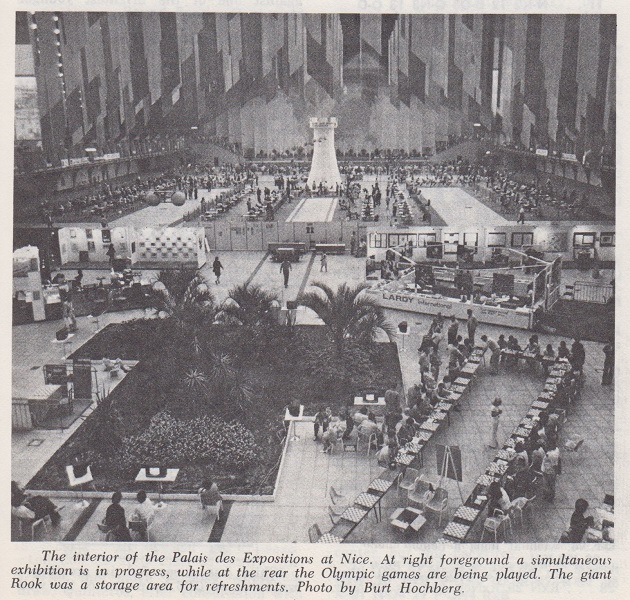
Chess Life & Review, October 1974, page 661.
11019. Nice, 1974
From the back cover of the Nice, 1974 Olympiad bulletins:
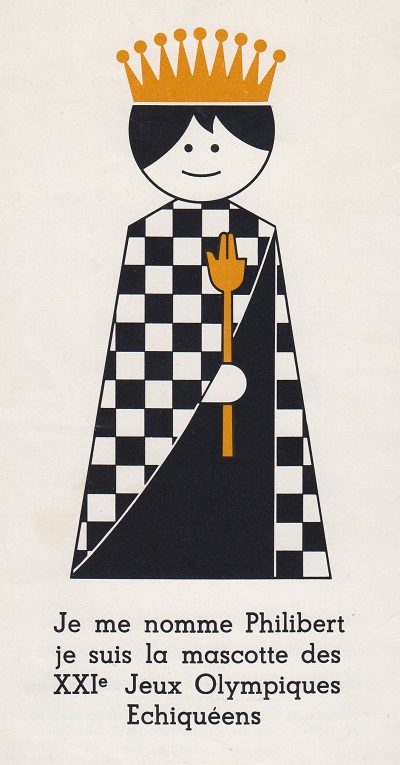
Major chess events often have, understandably, a logo (C.N. 10672), but any possible reason for a mascot is hard to discern.
11020. Lasker v Euwe
Noting that Emanuel Lasker was 67 when he defeated Euwe at Nottingham, 1936, José Carlos Santos (Porto, Portugal) asks whether any even older player has ever beaten a reigning world champion under standard tournament or match conditions.
We add that Lasker’s famous win was discussed on pages 23-24 of the January 1937 Australasian Chess Review in an article by T.A. Krishnamachari. Its title, ‘Cross-Attack’, is a seldom-seen technical term.

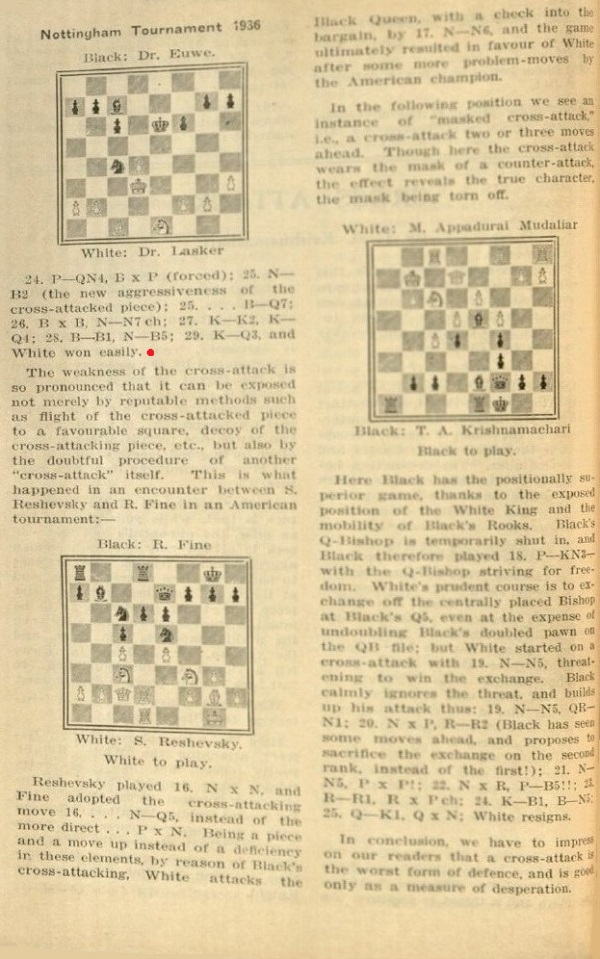
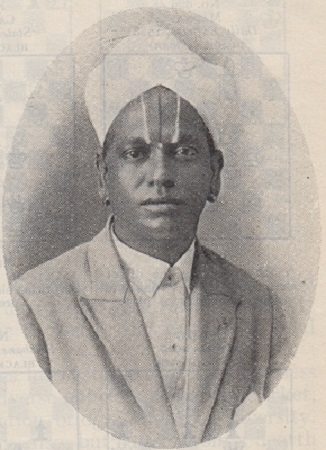
This photograph of T.A. Krishnamachari (also: Krishnamachariar) is taken from an article about him by T.R. Dawson on pages 31-32 of the January 1940 BCM. See too C.N. 3391 on pages 220-221 of Chess Facts and Fables, and the entry on pages 214-215 of Indian Chess History 570 AD-2010 AD by Manuel Aaron and Vijay D. Pandit (Chennai, 2014).
11021. Alekhine v Capablanca
The Dover reprint of the New York, 1924 tournament book included a few post-1924 photographs, including this one:
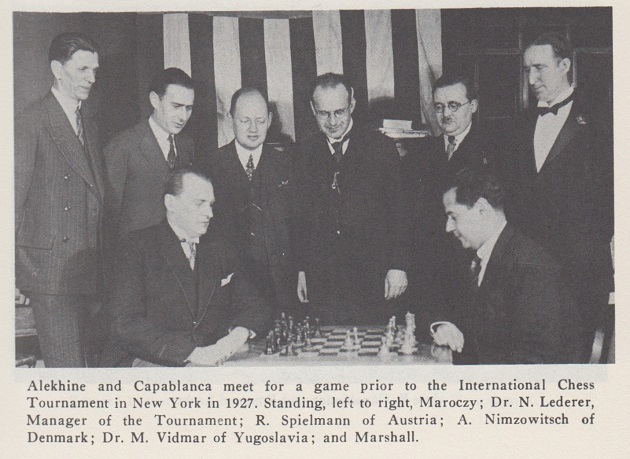
The phrase ‘meet for a game’ appears to be captionese, but is any more information available regarding the occasion?
11022. Incomplete
No volume entitled Complete Book of Chess History is ever likely to be published, for obvious sound reasons, but the word ‘complete’ is widely tolerated in the titles of beginners’ chess books.
Cardoza Publishing, Las Vegas has just brought out a new edition of Complete Book of Beginning Chess by Raymond Keene. As shown in Cuttings and on other C.N. pages, the previous edition (2003) had innumerable factual errors, such as this double mishap on page 241:

‘I’m not good at attention to detail’, stated Mr Keene uncontroversially on page 17 of the November 1990 CHESS. Since he is hopeless at chess history, the innumerable factual errors in the 2003 edition of Complete Book of Beginning Chess were mostly, though by no means only, in the last 100 or so pages, in the chapters entitled ‘The Heroes of Chess’, ‘The History of Chess’ and ‘The Best Games Ever Played’.
In the 2018 edition no textual amendments have been made anywhere (‘Rèti’ is still the spelling passim), except that, gratifyingly, those three final chapters have been silently removed.
There remains the logical conundrum of how the 2003 title Complete Book of Beginning Chess could be retained in 2018 for a new edition which is under half the weight of its predecessor and has deleted about one third of the content completely.
11023. Kasparov interview for learners of Russian
An addition to C.N. 8684 concerns pages 123-131 of part four of Читаем без проблем by N.A. Kostiuk (St Petersburg, 2013):
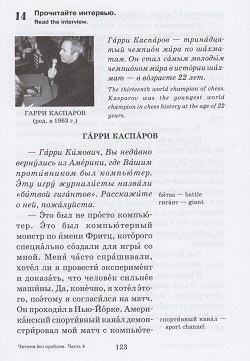
Page 127 specifies the source of the interview: Аргументы и факты, 50/2003 and 3/2004.
11024. The Predecessors series (C.N. 9839)
Have any corrected editions of Kasparov’s Predecessors series been published?
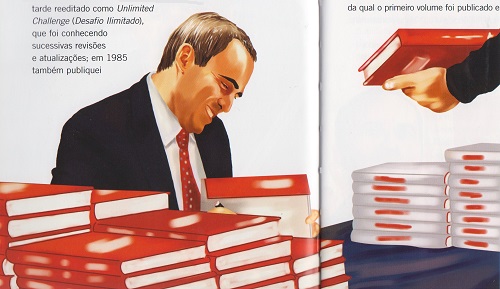
This illustration comes from pages 46-47 of the work mentioned in C.N. 9839: Chamo-me ... Garry Kasparov (Lisbon, 2011), Me llamo ... Garri Kasparov (Badalona, 2013) and Em dic ... Garri Kasparov (Badalona, 2013).
11025. Maróczy in conversation
On page 256 of CHESS, June 1947 B.H. Wood reported on a conversation with Géza Maróczy at Baarn, 1947:

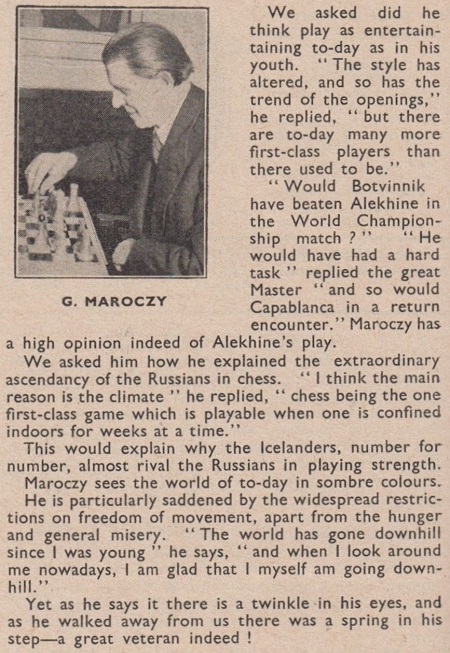
11026. Chess and politics
‘Your memory is regrettably short. Have you never heard of the Bordell case ...?’
See our latest feature article.
11027. Marshall v Chernev
Eduardo Bauzá Mercére (New York, NY, USA) has forwarded a game between Frank James Marshall and Irving Chernev (simultaneous exhibition, Brooklyn, 6 December 1919) on page 2 of section one of the Brooklyn Daily Eagle, 11 December 1919:
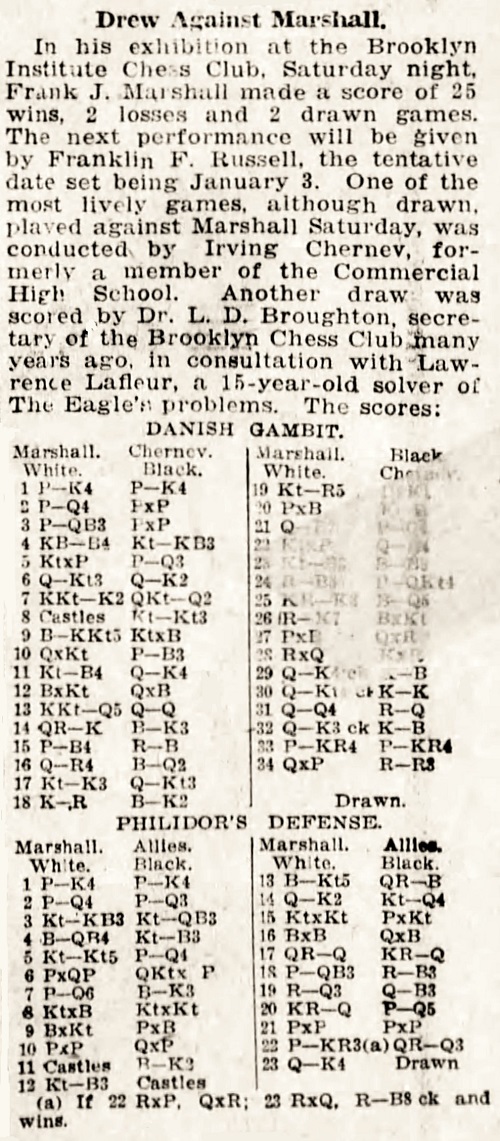
1 e4 e5 2 d4 exd4 3 c3 dxc3 4 Bc4 Nf6 5 Nxc3 d6 6 Qb3 Qe7 7 Nge2 Nbd7 8 O-O Nb6 9 Bg5 Nxc4 10 Qxc4 c6 11 Nf4 Qe5 12 Bxf6 Qxf6
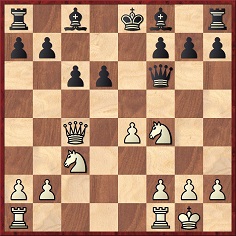
13 Nfd5 Qd8 14 Rae1 Be6 15 f4 Rc8 16 Qa4 Bd7 17 Ne3 Qb6 18 Kh1 Be7 19 Nf5 Bxf5 20 exf5 Kf8 21 Qc2 d5 22 Nxd5 Qc5 23 Nc3 Bf6 24 Rf3 b5
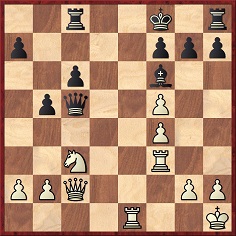
25 Rfe3 Bd4 26 Re7 Bxc3 27 bxc3 Qxe7 28 Rxe7 Kxe7 29 Qe4+ Kf8 30 Qb4+ Ke8 31 Qd4 Rd8 32 Qe3+ Kf8 33 h4 h5 34 Qxa7 Rh6 Drawn.
Marshall’s other game, against Broughton and Lafleur:
1 e4 e5 2 d4 d6 3 Nf3 Nc6 4 Bc4 Nf6 5 Ng5 d5 6 exd5 Nxd4 7 d6 Be6 8 Nxe6 Nxe6 9 Bxe6 fxe6 10 dxc7 Qxc7 11 O-O Be7 12 Nc3 O-O 13 Bg5 Rac8 14 Qe2 Nd5 15 Nxd5 exd5 16 Bxe7 Qxe7 17 Rad1 Rfd8 18 c3 Rc6 19 Rd3 Qf6 20 Rfd1 d4 21 cxd4 exd4 22 h3 Rcd6 23 Qe4 Drawn.
By chance, Olimpiu G. Urcan (Singapore) has sent us the chess column on page 8 of the Washington Post, 15 February 1920, which had the same two games and a similar text. He adds that a report on Marshall’s display had been published on page 2 of section one of the 8 December 1919 edition of the Brooklyn Daily Eagle:
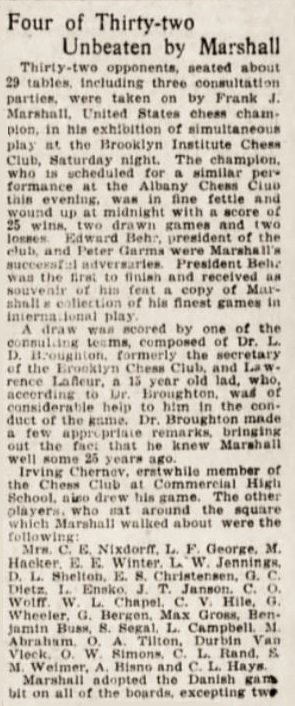
11028. A 1934 chess cartoon
An addition to ‘From Former Times (Chess)’:
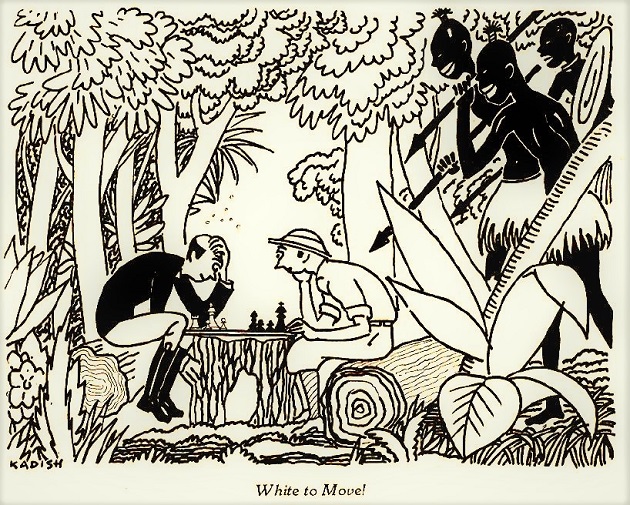
Source: Chess Review, August 1934, page 133.
11029. A very scarce periodical
Morten Lilleøren (Oslo) asks whether any reader has a run of Erich Otto Freienhagen’s magazine of the late 1920s and early 1930s Brief-Schach (entitled Fernschach-Courier until summer 1928). Our correspondent has only digital copies of some issues, and the Cleveland Public Library informs us that it holds two original issues from volume two, numbered 28-30 (‘Anfang August 1929’) and 31-33 (‘Ende August 1929’). Below are some of the pages supplied by the Library:
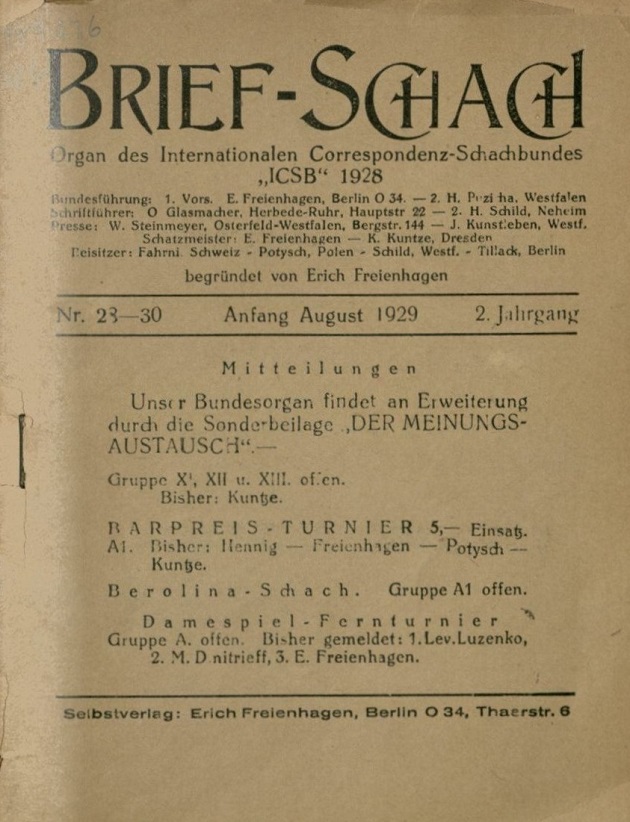
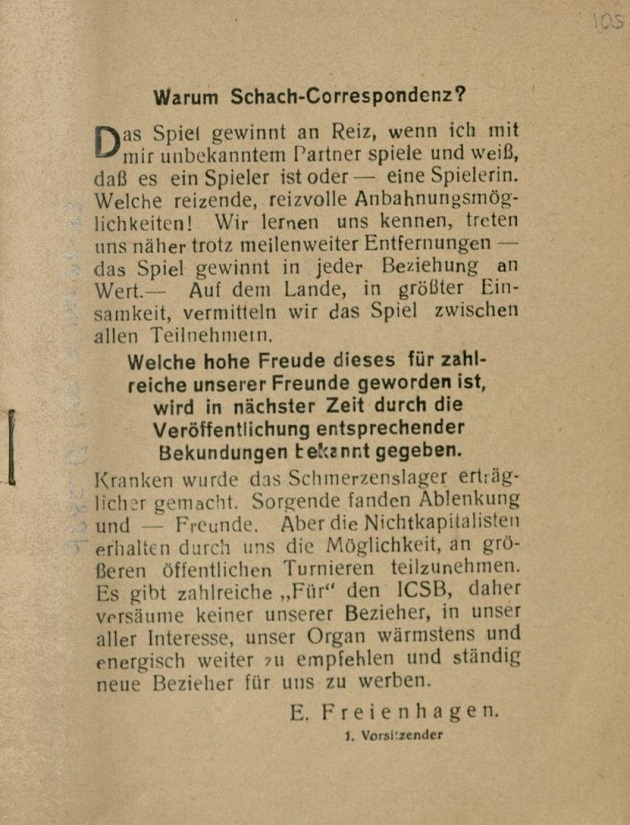
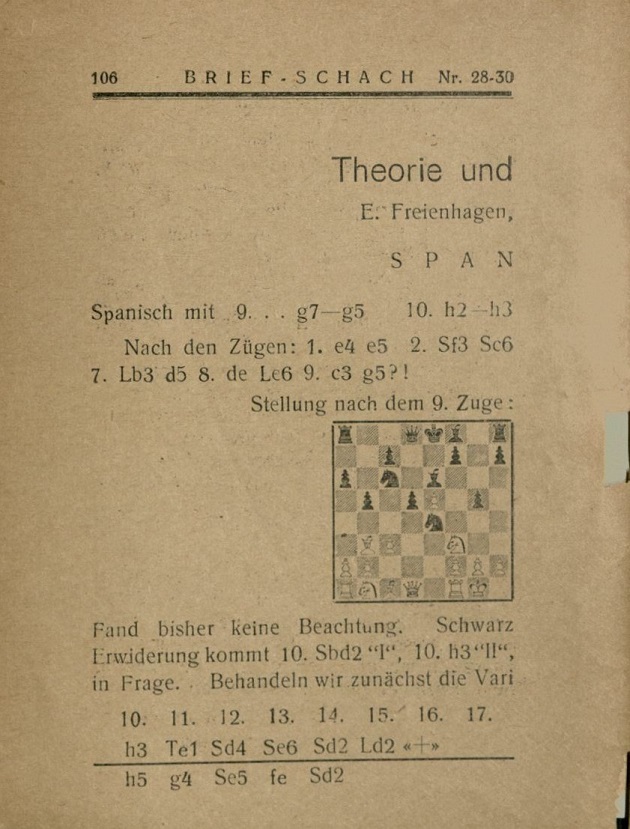
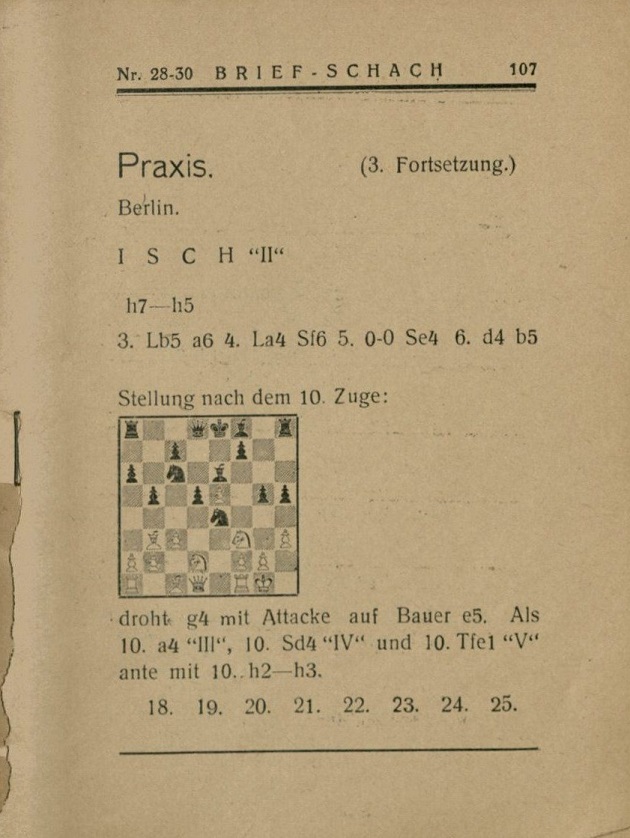
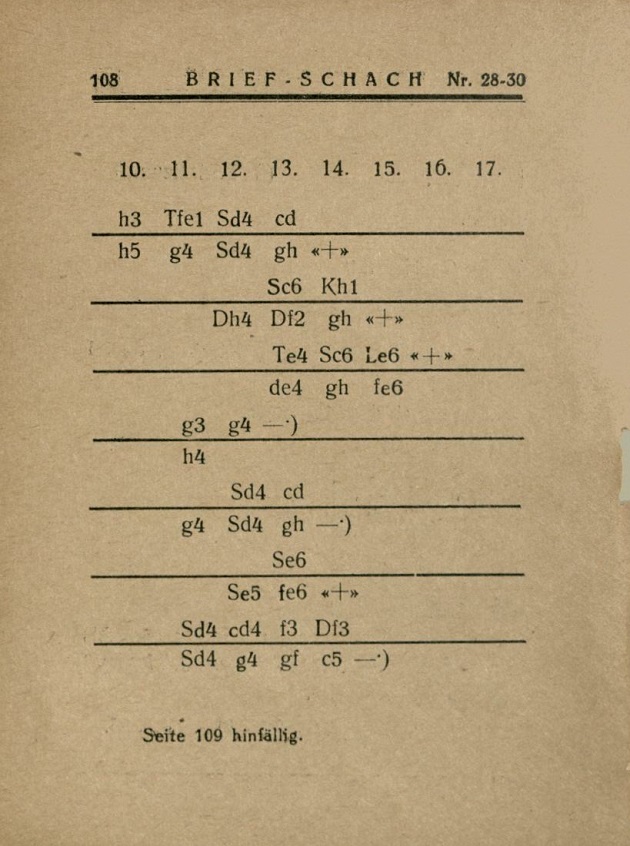
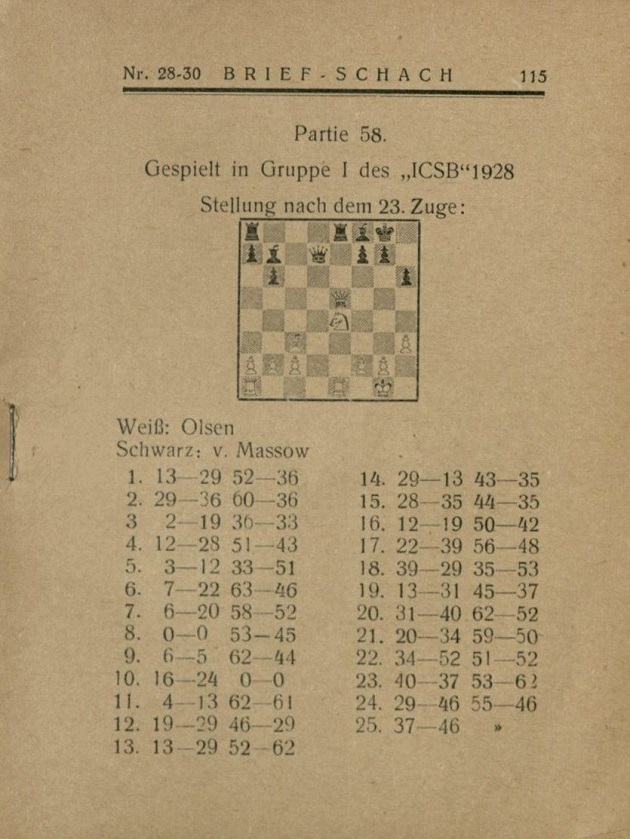
11030. Ludwig Steinkohl
Wanted: a biographical note on the prolific German chess writer Ludwig Wilhelm Steinkohl. The back cover of his book Faszination Fernschach (Düsseldorf, 1984):
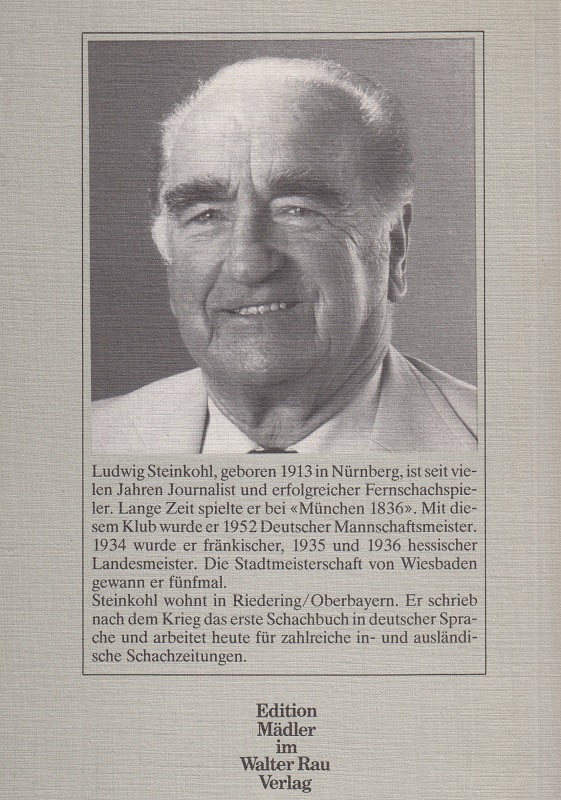
11031. Krishnamachari/Krishnamachariar (C.N. 11020)
Impressed by the article entitled ‘Cross-Attack’ shown in C.N. 11020, Sean Robinson (Tacoma, WA, USA) asks to see more of the Indian author’s output in the Hindu. C.N. 3391 (page 221 of Chess Facts and Fables) referred to the difficulty of tracing his columns and mentioned one, ‘Adjournment Analysis’, reproduced on page 168 of CHESS, April 1949:
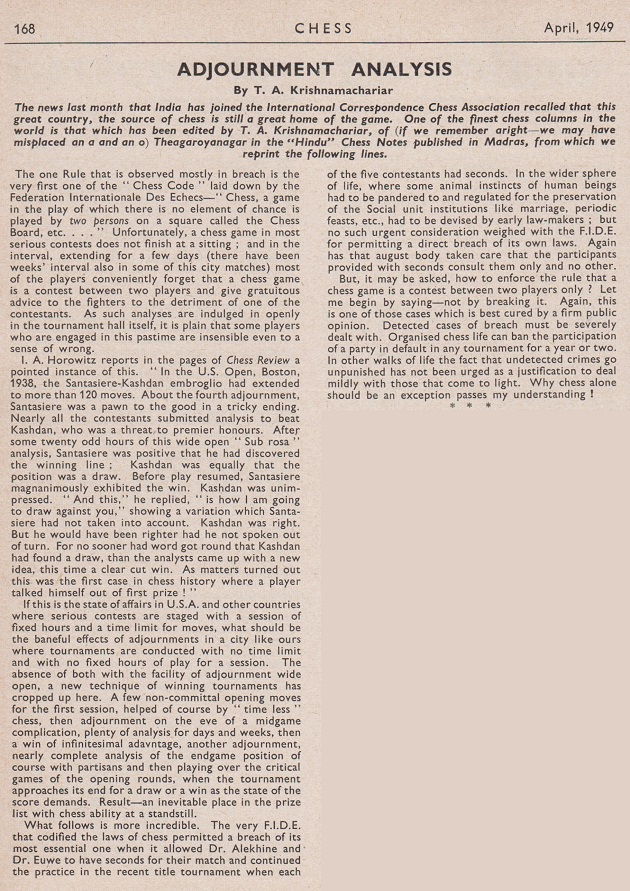
From page 33 of The World Chess Championship: 1951 Botvinnik v Bronstein by William Winter and R.G. Wade (London, 1951):
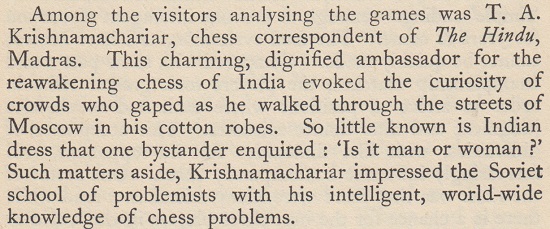
11032. Press-room analysis
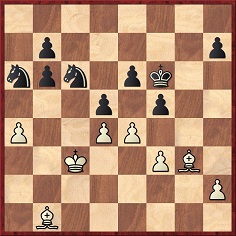
Black to move
Below is the paragraph preceding the one in C.N. 11031, from the 1951 Botvinnik v Bronstein match book by W. Winter and R.G. Wade, pages 32-33. The writer is Wade.

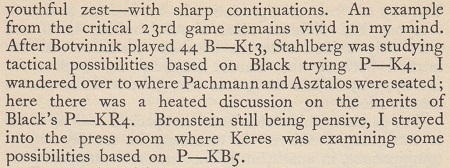
Bronstein did not play 44...e5, ...h5 or ...f4, but
...fxe4. The book (page 129) had no analysis or comment at
that point in the game.
11033. A reference to Steinitz
‘And it is in this respect that Agatha Christie repeats her Cards on the Table triumph and, as it were, plays and beats Steinitz with a single row of pawns.’
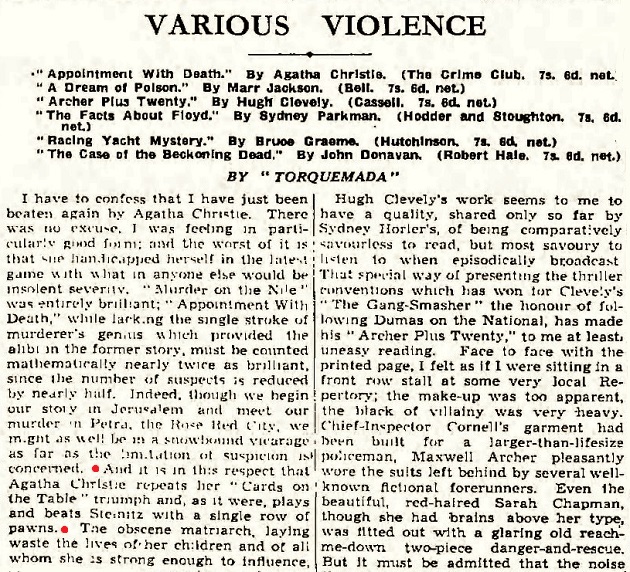
That review by ‘Torquemada’ of the Agatha Christie novel Appointment with Death comes from page 7 of the Observer, 1 May 1938.
11034. Krishnamachari/Krishnamachariar
Page 8 of the Linlithgowshire Gazette, 1 January 1932 published a win by the Indian:
1 e4 e5 2 f4 exf4 3 Nf3 h6 4 Bc4 Bc5 5 d4 Bb6 6 O-O a6 7 Bxf4 d6 8 Nc3 Nc6 9 Bxf7+ Kd7 10 Nd5 Nce7 11 Ne5+ dxe5 12 Qg4+ Kc6 13 Nb4+ Kb5 14 a4+ Ka5
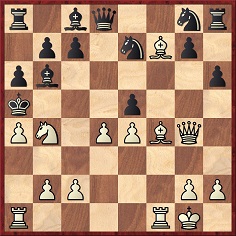
15 Nc6+ Nxc6 16 Bd2+ Nb4 17 Bxb4+ Kxb4 18 c3+ Ka5 19 b4 mate.
The only information about the game is that it ‘was given lately in La Vie Rennaise, we think, played in India’.
11035. A famous game revisited (C.N. 10951)
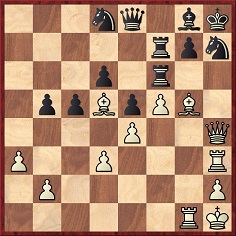
Position before 30 b3
Concerning Capablanca v Molina and Ruiz, Buenos Aires, 1914, Eduardo Bauzá Mercére (New York, NY, USA) notes a slightly earlier publication with the same annotations by Capablanca and the same misspelling of the allies’ names, on page 12 of the New York Sun, 31 January 1915:
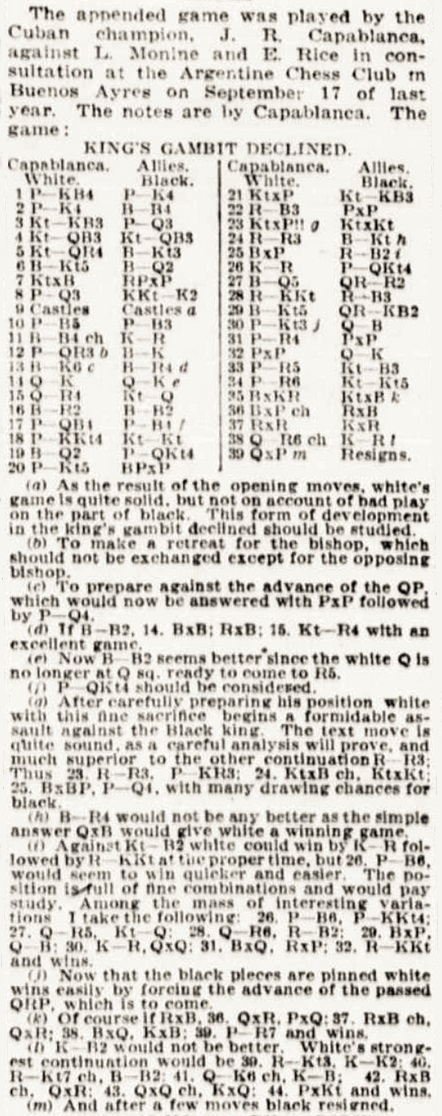
11036. One move deep
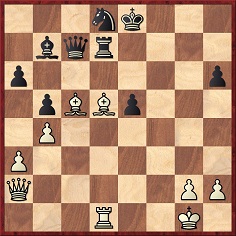
White to move
This position arose in a game won by Charles R. Gurnhill of Sheffield. It was published on page 260 of the Chess Amateur, June 1927, in the Games Department which he edited:
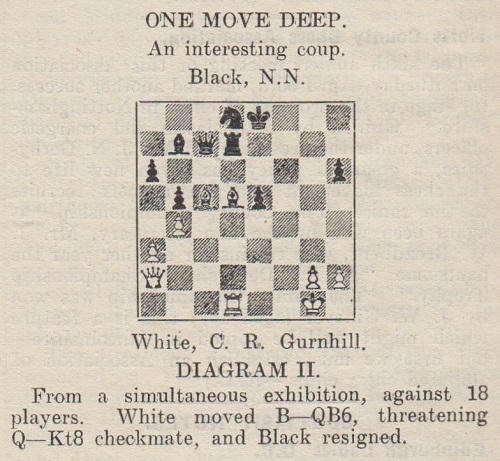
There is no record of many, or any, Chess Amateur readers being baffled by the position or asking why Black did not reply 1...Rxd1+.
From page 39 of Keene On Chess by Raymond Keene (New York, 1999):
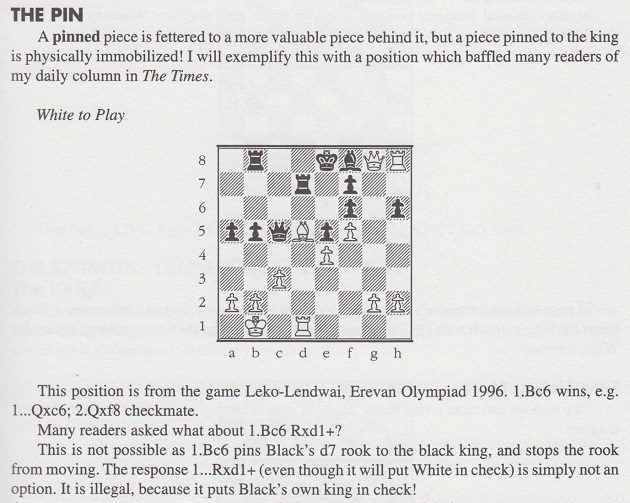
That takes up over half of one large page. The same text was repeated on page 39 of Raymond Keene’s Complete Book of Beginning Chess (New York, 2003) and on pages 40-41 of the Las Vegas, 2018 edition.
| First column | << previous | Archives [170] | next >> | Current column |
Copyright: Edward Winter. All rights reserved.